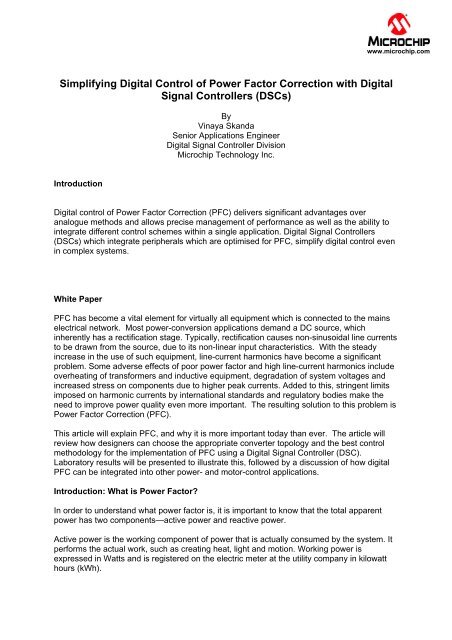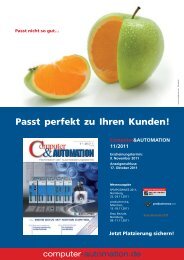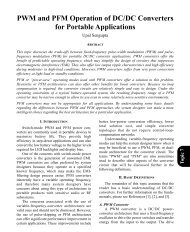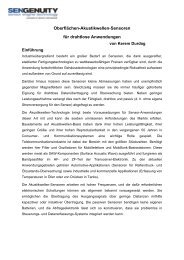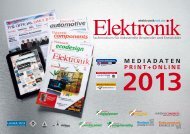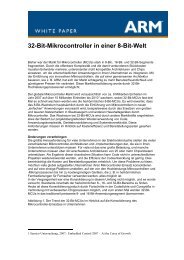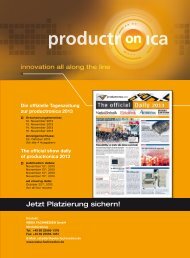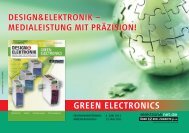Power Factor Correction Demystified - Energie & Technik
Power Factor Correction Demystified - Energie & Technik
Power Factor Correction Demystified - Energie & Technik
You also want an ePaper? Increase the reach of your titles
YUMPU automatically turns print PDFs into web optimized ePapers that Google loves.
www.microchip.com<br />
Simplifying Digital Control of <strong>Power</strong> <strong>Factor</strong> <strong>Correction</strong> with Digital<br />
Signal Controllers (DSCs)<br />
By<br />
Vinaya Skanda<br />
Senior Applications Engineer<br />
Digital Signal Controller Division<br />
Microchip Technology Inc.<br />
Introduction<br />
Digital control of <strong>Power</strong> <strong>Factor</strong> <strong>Correction</strong> (PFC) delivers significant advantages over<br />
analogue methods and allows precise management of performance as well as the ability to<br />
integrate different control schemes within a single application. Digital Signal Controllers<br />
(DSCs) which integrate peripherals which are optimised for PFC, simplify digital control even<br />
in complex systems.<br />
White Paper<br />
PFC has become a vital element for virtually all equipment which is connected to the mains<br />
electrical network. Most power-conversion applications demand a DC source, which<br />
inherently has a rectification stage. Typically, rectification causes non-sinusoidal line currents<br />
to be drawn from the source, due to its non-linear input characteristics. With the steady<br />
increase in the use of such equipment, line-current harmonics have become a significant<br />
problem. Some adverse effects of poor power factor and high line-current harmonics include<br />
overheating of transformers and inductive equipment, degradation of system voltages and<br />
increased stress on components due to higher peak currents. Added to this, stringent limits<br />
imposed on harmonic currents by international standards and regulatory bodies make the<br />
need to improve power quality even more important. The resulting solution to this problem is<br />
<strong>Power</strong> <strong>Factor</strong> <strong>Correction</strong> (PFC).<br />
This article will explain PFC, and why it is more important today than ever. The article will<br />
review how designers can choose the appropriate converter topology and the best control<br />
methodology for the implementation of PFC using a Digital Signal Controller (DSC).<br />
Laboratory results will be presented to illustrate this, followed by a discussion of how digital<br />
PFC can be integrated into other power- and motor-control applications.<br />
Introduction: What is <strong>Power</strong> <strong>Factor</strong>?<br />
In order to understand what power factor is, it is important to know that the total apparent<br />
power has two components—active power and reactive power.<br />
Active power is the working component of power that is actually consumed by the system. It<br />
performs the actual work, such as creating heat, light and motion. Working power is<br />
expressed in Watts and is registered on the electric meter at the utility company in kilowatt<br />
hours (kWh).
www.microchip.com<br />
Reactive power doesn’t do any useful work, but it is required to maintain and sustain the<br />
electromagnetic field associated with inductive elements and loads. Reactive power is<br />
expressed in Volt Amperes Reactive (VAR) and is registered on the electric meter at the<br />
utility company in kilo Volt Ampere Reactive (kVAR). The total required power capacity,<br />
known as apparent power, is expressed in simply kilo Volt Amperes (kVA).<br />
Using the above power components, power factor is a parameter that can be defined as the<br />
amount of working power used by a system, in terms of the total apparent power. Ideally, the<br />
power factor for a given system should be unity. However, in actual systems, the power<br />
factor deviates from unity for the following reasons:<br />
Phase shift of current with respect to voltage, which results in displacement. This is<br />
sometimes called the “Displacement <strong>Factor</strong>.”<br />
Harmonic content present in the current that results in waveform distortion. This can<br />
be termed as “Distortion <strong>Factor</strong>.”<br />
Now, power factor can be alternatively defined as the product of distortion factor and<br />
displacement factor. <strong>Power</strong> factor becomes an important measurable quantity and a figure of<br />
merit because it often results in significant economic savings for utility companies.<br />
The objective of PFC is to make the power converter present itself as a linear resistance to<br />
the input voltage. If the input voltage has a sine-wave shape, the input current will also have<br />
a sine-wave shape. This allows the power distribution system to operate more efficiently,<br />
thereby reducing energy consumption.<br />
Cause and Effect of Current Harmonics<br />
Current harmonics are sinusoidal waves that are integral multiples of the fundamental wave.<br />
They are altogether different from line disturbances, such as transient distortions and power<br />
surges. Current harmonics appear as continuous, steady-state disturbances on the electric<br />
network.<br />
Some of the common causes of current harmonics are:<br />
<strong>Power</strong> electronic equipment, such as rectifiers, Uninterruptible <strong>Power</strong> Supplies<br />
(UPSs), state converters, thyristor systems, Switch Mode <strong>Power</strong> Supplies (SMPSs)<br />
and SCR-controlled systems, among others.<br />
Commonly used industrial equipment, such as welding machines, arc furnaces, and<br />
mercury vapor lamps.<br />
Saturable inductive equipment, such as generators, motors and transformers.<br />
The problems caused by current harmonics include:<br />
Erroneous operation and nuisance tripping of system components, such as circuit<br />
breakers, fuses and relays.<br />
Damage to sensitive electronic equipment.<br />
Excessive overheating of capacitors, transformers, motors, lighting ballasts and other<br />
equipment.<br />
Interference with neighboring electronic equipment.<br />
To reduce these harmful effects, the current drawn from the input needs to have a similar<br />
shape to that of the input-voltage profile.
www.microchip.com<br />
How Can a Converter be Made to Look Resistive?<br />
The answer to this question lies in the fact that PFC is a low-frequency requirement. This<br />
means that the converter does not need to be resistive at all frequencies, provided a filtering<br />
mechanism exists to remove the high-frequency ripples. Using the four basic power<br />
components—namely, inductor, capacitor, diode and switch—a converter can be made to<br />
look resistive. At this point, the reactive energy, which would otherwise cycle back to the<br />
utility company or grid, needs to be localized and contained within the PFC converter.<br />
Traditionally, bulk inductors and capacitors were used to compensate for downstream loads,<br />
which would be leading or lagging, respectively. The bulk components would store energy<br />
over one power cycle. The downside of this approach is increased cost and an inability to<br />
correct for harmonics. However, with the advent of DSCs and advanced power electronics,<br />
the energy-storage elements can be downsized because they only need to store energy for a<br />
small period of time, on the order of a few tens of microseconds. With this approach, the<br />
harmonics can also be effectively addressed.<br />
Topological Considerations for PFC<br />
Figure 1 illustrates a basic block diagram of a generic power-converter system with PFC.<br />
The rectifier converts the AC input to a unidirectional pulsating output, which acts as the<br />
input to the PFC converter. The PFC converter can be one of several different topologies—a<br />
Buck converter, a Boost converter or a Buck-Boost converter. The DSC takes the three<br />
signals VAC, IAC and VDC as feedback for the control loop. The only outputs of the DSC are<br />
the PWM pulses for switching the PFC MOSFET.<br />
Figure 1:<br />
Basic Block Diagram of a <strong>Power</strong> Converter<br />
Let us look at the various topologies in order to decide which would suit the PFC application.<br />
Figure 2 shows the Buck, Boost and Buck-Boost topologies of power converters. Table 1<br />
compares the three converters, based upon the various parameters. It can be concluded that<br />
the Boost converter is best suited for the implementation of PFC because of the absence of<br />
crossover distortions and viability of operating the converter in continuous-conduction mode.<br />
There are many ways to control a Boost converter.
www.microchip.com<br />
In discontinuous conduction mode, the inductor current returns to zero at the end of every<br />
switching cycle, thereby having lower switching losses. Since the current goes to zero at<br />
each switching cycle, the peak current through the inductor and hence through the switching<br />
devices is comparatively more than in continuous-conduction mode.<br />
Critical-conduction mode is the optimization of discontinuous mode to the point of continuous<br />
mode operation. Here, peak current and Total Harmonic Distortion (THD) are more than in<br />
continuous-conduction mode, but lower than the discontinuous-conduction mode of<br />
operation. Critical-conduction mode operates on a variable switching frequency, wherein<br />
depending upon the load and input voltage, the switching frequency will vary.<br />
Continuous-conduction mode strives to maintain a non-zero current through the Boost<br />
inductor to minimize peak current levels. This will in turn reduce losses when compared to<br />
discontinuous-conduction and critical-conduction modes. This mode is more suitable for<br />
higher power levels, although the control strategy is more complex.<br />
Type of Converter Output Voltage<br />
Polarity<br />
Crossover<br />
Distortions<br />
Line<br />
Current Shape<br />
Buck Positive Yes Always<br />
Discontinuous<br />
Boost Positive No Continuous*<br />
Buck-Boost Negative No Always<br />
Discontinuous<br />
*Based upon load conditions and inductor value, continuous currents can be obtained in a<br />
Boost converter.<br />
Table 1:<br />
Comparison of Three Types of PFC Converters
www.microchip.com<br />
Buck Converter<br />
V 1<br />
S<br />
L<br />
+<br />
i<br />
+<br />
i<br />
V 1<br />
D<br />
C<br />
V 2<br />
-<br />
-<br />
Boost Converter<br />
L<br />
D<br />
V 1<br />
+<br />
i<br />
+<br />
V 1<br />
S C V 2<br />
-<br />
i<br />
-<br />
Buck-Boost Converter<br />
S<br />
V 1<br />
D<br />
+<br />
i<br />
-<br />
V 1 L<br />
V 2<br />
-<br />
C<br />
+<br />
i<br />
0<br />
V 2 < V 1<br />
ωt<br />
ωt<br />
<br />
- <br />
V 2 > V 1<br />
ωt<br />
ωt<br />
0<br />
V 2 > V 1<br />
<br />
V 2 < V 1<br />
ωt<br />
ωt<br />
0 <br />
Figure 2:<br />
<strong>Power</strong>-Converter Topologies<br />
Digital Implementation of <strong>Power</strong> <strong>Factor</strong> <strong>Correction</strong><br />
Figure 3 illustrates the digital implementation of PFC using a DSC. The method used here is<br />
called Average Current-Mode Control. In this method, the average current flowing through<br />
the inductor is forced to be a sine wave and the output voltage is regulated. To derive the<br />
sine shape for the average inductor current, either a sinusoidal pattern can be generated in<br />
software or the rectified voltage, itself, can be used. The scheme here uses the rectified<br />
voltage to get the necessary shape of inductor current. T S is the total PWM switching period,<br />
t ON is the MOSFET conduction time and t OFF is the time during which the MOSFET is turned<br />
off. The time t ON is controlled by implementing the digital-control system described next, in<br />
order to achieve the necessary inductor-current shape.<br />
The following control loops and compensators are implemented digitally, through software:<br />
Current Loop<br />
The inner loop in the control block forms the current loop. The inputs to the current loop are<br />
the reference current signal from the outer loop and the inductor current. The current error<br />
compensator is designed to produce a control output such that the inductor current follows<br />
the reference current signal. The current loop should run at a much faster rate when<br />
compared to the voltage loop. The bandwidth of the current compensator should be higher<br />
for correctly tracking the semi-sinusoidal waveform at twice the input frequency, which is 100<br />
Hz or 120 Hz. Usually, the bandwidth of the current compensator is between 5 kHz and 10<br />
kHz for a switching frequency of around 100 kHz.
www.microchip.com<br />
Component sizes would be small at these switching frequencies. The current controller<br />
produces a duty-cycle value to drive the gate of the PFC MOSFET. A proportional-integral<br />
controller is used to achieve the current-error compensation.<br />
Voltage Loop<br />
The outer loop in the control block forms the voltage loop. The input to the voltage loop is the<br />
reference DC voltage and the sensed output voltage. The voltage-error compensator is<br />
designed to produce a control output such that the DC output voltage remains constant at the<br />
reference value, regardless of variations in the load current and changes in the supply<br />
voltage. The voltage controller produces a control signal, which determines the reference<br />
current for the inner current loop. The voltage-loop bandwidth is chosen to be 10 Hz. This is<br />
selected to be well below the input frequency of 100 Hz or 120 Hz, so that the output voltage<br />
remains constant and still maintains the necessary shape of the inductor current, without<br />
distorting it. A proportional-integral controller is used to achieve the voltage-error<br />
compensation.<br />
Voltage Feed-Forward Compensator<br />
If the voltage decreases, the product of V AC and V PI , which determines current reference,<br />
also proportionally decreases. However, to maintain a constant output power at a reduced<br />
input voltage, the current reference must increase. The purpose of having an input voltage<br />
feed-forward term is to maintain the output power constant, as determined by the load,<br />
regardless of sudden variations in the input-line voltage. This compensator is implemented<br />
digitally by calculating the average value of the input-line voltage and using the result as a<br />
divider for the current reference. This resulting signal acts as the input to the inner current<br />
loop.<br />
Figure 3:<br />
Average Current-Mode Control
www.microchip.com<br />
Integration of PFC With Other Applications<br />
Most power-conversion applications use PFC as the front-end converter, be it in the area of<br />
SMPS or motor-control applications.<br />
Let us consider an integrated application, as in the case of a home air conditioner. Taking a<br />
look at the Figure 4, we can see the input converter features an active PFC stage, which<br />
helps to meet the stringent regulatory needs stipulated by various countries. The DSC’s<br />
Analog-to-Digital Converter (ADC) module measures the required feedback currents and<br />
voltages. Based upon these, the PWM module drives the power switch. This on-chip PWM<br />
module runs under the two PI controllers in order to maintain a near unity power factor.<br />
Using the same DSC, the sensorless Field Oriented Control (FOC) algorithm takes phase<br />
currents as feedback through the ADC module. The same on-chip PWM module is used to<br />
drive the inverter’s power switches running under multiple PID controllers for speed and<br />
torque control of the air-conditioner compressor.<br />
A single DSC used for the implementation of both PFC and FOC algorithms results in major<br />
cost savings over the same implementation using non-DSC-based solutions. This is<br />
because the latter require the use of expensive ASICs and fixed-functionality devices. The<br />
final goal of reducing the stress on the electric grid using PFC, and at the same time<br />
efficiently controlling the air conditioner motor, is facilitated using the DSC.<br />
Many such applications are being integrated with PFC on a single DSC chip, thus making<br />
power conditioning an integral part of the system. Some examples include server power<br />
supplies, UPSs, telecom rectifier supplies, washing machines, refrigerators, gaming<br />
consoles, digital lighting, television sets and many more.<br />
Figure 4:<br />
Integrated PFC and FOC in an Air Conditioner
www.microchip.com<br />
Conclusion and Experimental Results<br />
The experimental results shown in Figure 5 validate the digital implementation of PFC using<br />
a dsPIC ® DSC. The yellow waveform is the input current and the blue waveform is the input<br />
voltage. This shows that the input current is shaped according to the voltage, resulting in a<br />
near-unity power factor. Implementation of PFC enables substantial cost savings for power<br />
quality, depending upon the pricing structure provided for the consumer. PFC can also<br />
reduce losses for utility companies.<br />
Summary<br />
Figure 5:<br />
Input Current and Input Voltage Waveforms with PFC<br />
PFC is no longer a choice—it has become a requirement for most power-conversion<br />
applications. In this article, we have seen some fundamental concepts governing power<br />
quality and the issues faced in distribution systems if PFC is not implemented. The digital<br />
implementation of PFC proves to be advantageous over analog implementations because it<br />
enables precise control of performance and the ability to merge and integrate many control<br />
schemes in integrated applications. The advent of DSCs with application-specific peripherals<br />
on-chip has made the digital implementation for complex applications with PFC possible for<br />
today’s and tomorrow’s world of power.<br />
###
www.microchip.com<br />
About Microchip Technology<br />
Microchip Technology Inc. (NASDAQ: MCHP) is a leading provider of microcontroller and<br />
analog semiconductors, providing low-risk product development, lower total system cost and<br />
faster time to market for thousands of diverse customer applications worldwide.<br />
Headquartered in Chandler, Arizona, Microchip offers outstanding technical support along<br />
with dependable delivery and quality. For more information, visit the Microchip website at<br />
http://www.microchip.com.<br />
References<br />
1. Microchip Technology Application Note #AN1106, “<strong>Power</strong> <strong>Factor</strong> <strong>Correction</strong> in <strong>Power</strong><br />
Conversion Applications Using the dsPIC ® DSC,” by Vinaya Skanda.<br />
2. Microchip Technology Application Note #AN1208, “Integrated <strong>Power</strong> <strong>Factor</strong><br />
<strong>Correction</strong> (PFC) and Sensorless Field Oriented Control (FOC) System,” by Vinaya<br />
Skanda.<br />
3. Microchip Technology Application Note #AN1078, “Sensorless Field Oriented Control<br />
of PMSM Motors using dsPIC30F or dsPIC33F Digital Signal Controllers,” by Jorge<br />
Zambada.<br />
4. Microchip Technology Application Note #AN908, “Using the dsPIC30F for Vector<br />
Control of an ACIM,” by Dave Ross and John Theys.<br />
Note: The Microchip name and logo, dsPIC, and PIC are registered trademarks of Microchip Technology Inc. in<br />
the U.S.A. and other countries. All other trademarks mentioned herein are property of their respective<br />
companies.<br />
MCA483wp


